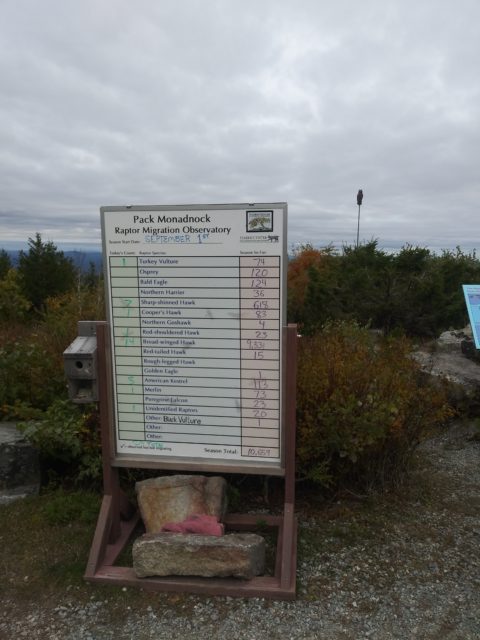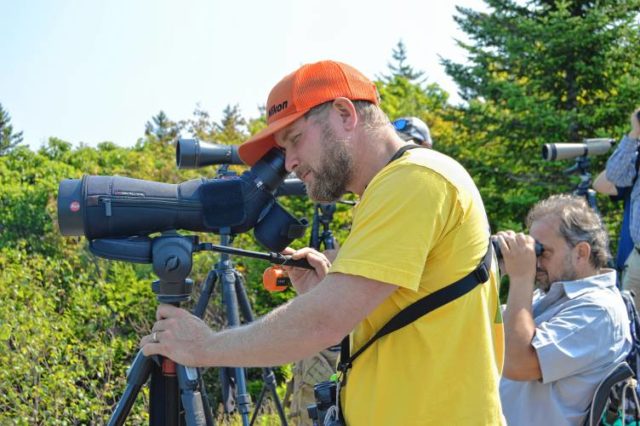Kayla Drake- SCA NH Corps – Discover the Power of Parks Interpretive Ranger
Pack Monadnock Raptor Observatory
Atop the summit of Pack Monadnock, a crowd is growing. All reservations for the day have been taken, and people are arriving in flocks. Some regulars are there, scanning the sky with their eyes, binoculars, or scopes. All this happens in the hopes of observing the migration of raptors.
The Raptor Observatory atop Miller State Park’s Pack Monadnock is one of over 200 hawk watch sites around the US, which the Hawk Migration Association of North America (HMANA) collects data from. This site, where they tally the migrating raptors they see, is staffed yearly from Sept 1st to November 20th.
But what even is a raptor? A raptor is a carnivorous bird, characterized by a sharp, hooked beaks, keen eyesight, and eight sharp talons. This includes species like eagles, ospreys, hawks, falcons, and more.

Levi Burford, head bird counter, is responsible for –you guessed it– counting birds. He is paid to be present and counting at the site from 9-5 four days a week, with volunteers standing in for the days he is not there. The Harris Center for Conservation Education funds and staffs this site, as well as providing education for guests and school groups.

On one day alone during the 2022 season, we saw over 5,000 broad wing hawks. The broad winged hawk makes up about 75% of what is seen at Pack Monadnock. The runner up is the sharp-shinned hawk but its numbers are much lower. You can find the updated counts at hawkcount.org, where all hawk watch sites upload their observations. The season is ongoing until November 20th, so feel free to check up on the numbers.
Importance of Hawk Watch Sites
Watching hawks is a hobby for many, but it also is a crucial part of conservation. The data from all the hawk watch sites comes together to provide information on population trends and ranges for many different raptors.
For example, the numbers of osprey and northern harriers are trending downwards in recent years, which is a signal that wildlife biologists can use to increase conservation efforts for a species. In addition, for the first time last year, a black vulture was observed from the site. This shows that there has been a change in the space that black vultures occupy.
This work is also crucial in engaging the public, as sites like this provide a place for the public to learn in an engaging way.

Raptors are also important to monitor because they are good indicators of environmental health. This is because:
- They inhabit most ecosystem types
- They occupy large home ranges
- They feed at the top of the food web
- They are highly sensitive to chemical contamination/other human disturbance (DDT)
Furthermore, we count raptors because they are easy to tally when they congregate during migration. They tend to use updrafts and thermals to travel, which means that they can be found in large numbers where those conditions are.
Migration
Often we think that birds migrate to escape the cold winter weather. Actually, their feathers ensure they are well equipped to handle cold weather — consider what we put inside our jackets and comforters to create warmth: down feathers.
In reality, migration has less to do with cold and more to do with food sources. Some raptors eat smaller birds, and so as their food migrates south, they must follow it. Other raptors, like ospreys, must find waters that do not freeze. Ospreys’ diet is made up of 98% fish, so often they migrate to find water that provides a viable fishing ground.
Birds must migrate up to thousands of miles. For a journey so long, they tend to take advantage of certain conditions to make their trip more efficient. An updraft is a result of the air rising as it hits a mountain, which allows birds to get some lift. A thermal is when the warm air rises, and this is another way birds can get lift. For every one mile up a thermal takes them, they can soar for about twelve miles.

Visiting the Raptor Observatory
The Pack Monadnock Raptor Observatory is located at the summit of Pack Monadnock, elevation 2290. The summit is encompassed by Miller State Park, the oldest state park in New Hampshire. Between the bird watchers and the fall-foliage spectators, the state park is incredibly busy from September through October, so be sure to reserve your spot in advance to guarantee admission. Reserve your spot here today! https://www.nhstateparks.org/planning/day-use-reservations
The great thing about this summit is its accessibility. There are many ways to get to the top. Miller State Park features two trails and an auto road. Park staff typically recommends going up the yellow Wapack trail, which is a steep, rocky trail up the mountain. Then you can take a nice walk through woods and over roots to get back down, via the blue Marion Davis Trail. Unlike nearby Monadnock State Park, you can even bring your furry friends with you to the summit.


Many guests choose instead to drive up to the summit, via our 1.3 mile auto road. However, the auto road makes for a nice walk up or down, as well. So there is something for everyone, in terms of ways to get up the mountain.


The summit is well-equipped, complete with two pit toilets and many picnic tables. The state park even features a store with snacks, gear, ice cream, drinks, souvenirs, and anything else you could possibly need. Around the side of the store, there is a source of potable (tested weekly) drinking water with a metal bowl placed below for your furry friends to drink from.
Down a small gravel path, you will find the Raptor Observatory– just follow the green signs labelled Raptor Observatory, between Sept 1st and November 20th.

Remember to bring a pair of binoculars, or pick up a pair from the park store. Migrating birds tend to be pretty distant, as they travel high up on the winds. However, it is always possible to get the treat of a close bird; there is an owl decoy by the name of Gina that stands watch over the observatory. Small, feisty raptors, such as the sharp-shinned hawk and the merlin, will often swoop in to scare this owl away. If you stop by, you may be lucky enough to witness this sight!
Special Events at the Observatory
The Raptor Observatory is a great place to visit any day, but between September 1st and November 20th, there are many amazing events to attend there as well. The Harris Center for Conseration Education hosts these events, which you can keep up with here: https://harriscenter.org/events.
During September, there is typically a public hawk watch event of some sort, with educators present to engage with the public. A favorite event that takes place is the Hawk Release. Hawk rehabilitator Maria Colby brings hawks that have been nursed back to full health, and they are released at the summit.

In October, there is an event called the Big Sit, in which the counters try to tally as many bird species as possible in one day. They will count all birds, going beyond the typical raptor count.
Whether you go to see the migrating raptors, to enjoy the hike with your furry friends, to peek at the fall foliage, or to take in the incredible view, Miller State Park is worth a visit. Reserve your spot today at https://www.nhstateparks.org/planning/day-use-reservations.
